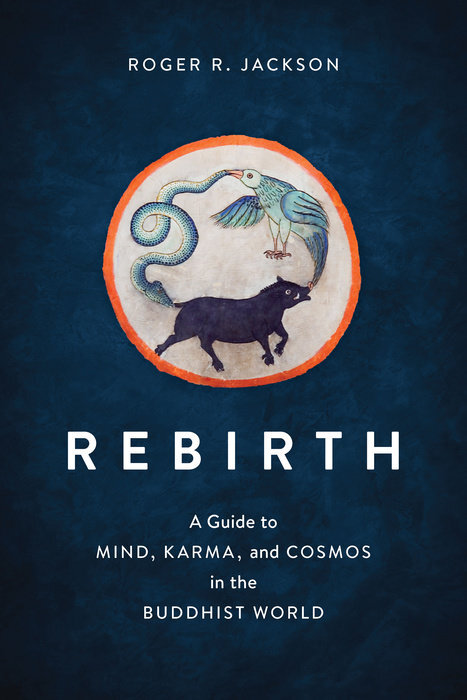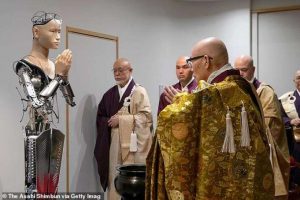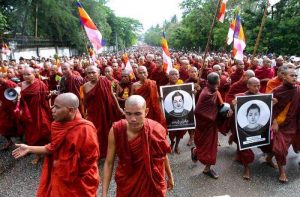There is perhaps no concept more central to the Buddhist worldview, yet more misunderstood and misused in modern parlance, than rebirth. His Holiness the Dalai Lama once said that the entire motivation and ethic of being a Buddhist hinged on rebirth, and it is the one religious idea that cannot be reduced to metaphor or allegory. It cannot be adjusted in the same way that the idea of a literal Mount Meru can be revised in light of how we now understand outer space. Roger R. Jackson’s Rebirth: A Guide to Mind, Karma, and Cosmos in the Buddhist World (Shambhala Publications 2022) concentrates its energy on the singular matter of rebirth. Since it is both so central to the Buddhist worldview, yet so commonly misunderstood, Jackson’s new book is almost like a public service.
The author’s objective from the outset is not to convince the reader of the possibility of rebirth, but rather to “broadly survey two thousand-plus years of Buddhist discourse on the subject.” (xiv) There are 15 chapters, with Chapter 1 laying the groundwork for how rebirth has existed as an idea in the ancient world. In Chapter 2, Jackson weaves an engaging story about how what he calls “the saṃsāra-karma-mokṣa worldview” arose in ancient India. What we see in the north Indian world of the sixth and fifth centuries BCE is, as revealed in the early Upaniṣads and the earliest Buddhist and Jain texts, is the following:
. . . new social and economic formations were coming into being, helping to upset long-established norms; the saṃsāra-karma-mokṣa cosmology increasingly (though not uniformly or uncontested) was used to frame the human condition; and the cities and forests teemed with philosophers, ascetics, and yogis—brāḥmaṇas and śramaṇas alike—who sought to solve the riddle of existence and show suffering beings the way out of the vicious circle of rebirths, or at least to some semblance of happiness in this life.
(25–26)
Chapter 3 is perhaps the one that many readers will hurry to, for it takes head-on the Buddha’s perspective on rebirth. Yet caution must be applied. German-born Bhikkhu Analayo, a monk and scholar who has published prolifically on early Buddhism, critical Buddhist history, and textual studies, has written that we cannot know with full certainty what the historical Buddha thought or taught about rebirth. Jackson is in agreement with this sober view (27). Nevertheless, he highlights how early texts such as the Dhammapada, the Dhammacakkapavatthana Sutta, and the Mahāsīhanāda Sutta indicate clearly that the Buddha’s objective in spiritual practice was the ending of rebirth. Chapters 4, 5, and 6 address systematically the three key questions, respectively: where, how, and why rebirth happens. This involves an in-depth discussion of the cosmos as the Buddhist masters understood it in Chapter 4 and the Twelve Links of Dependent Origination as the driver of this vehicle of rebirth in Chapter 5. Chapter 6’s explanation of the mysterious mechanics of karma ties together why rebirth should even happen and be propelled in a world of Buddhist metaphysics and Dependent Origination.
With the foundations of the Buddha’s universe of rebirth in place, Jackson distinguishes between what the canonical tradition has officially proclaimed about a core doctrine, and how it has existed as a lived tradition among its everyday devotees. Jackson stresses this in his seventh chapter (97–99), which is about popular traditions of rebirth. The distinction could be “high” and “low” Buddhism, “popular” and “elite” Buddhism, or even Buddhism as nibbanic, kammatic, and apotropaic—terms coined by anthropologist Melvin E. Spiro:
. . . normative values and rhetoric notwithstanding—very few Buddhists, even monastics, have seriously aimed at the tradition’s summum bonum, nirvāṇa, since the time, discipline, and social circumstances required for the contemplative life that leads to it were difficult to obtain, even in ancient India.
(98)
Jackson contrasts Chapters 8 and 9 with the early Indic conception of rebirth, devoting his analysis respectively to Indian Mahayana Buddhist views and those of the tantric tradition. Finally, in closing the Indic emphasis of his study (Indian Buddhism is the book’s primary concern) Chapter 10 highlights how the Buddhist tradition has attempted to explain and convince the worldview of rebirth, and therefore the salvific necessity of the Buddha’s message.
Chapter 11 onwards can be seen to be Jackson’s examination of how the original Indic idea of rebirth was exported and became a local idea beyond Buddhism’s ancient borders. The chapter addresses this spread and how Theravada views became rooted in various non-Indian cultures. Chapter 12 discusses East Asian views on rebirth, and Chapter 13 looks at Inner Asian ideas of rebirth. In all three chapters one can see the intellectual and philosophical continuity between the regions in which Buddhism takes root and the early Indian perspective, but Jackson leaves us in no doubt that rebirth in Southeast Asia, East Asia, and Inner Asia are their own intellectual branches, deserving of separate studies.
Chapters 14 and 15 discuss the relationship between contemporary Buddhism and rebirth, and the contemporary debates that provide some indications of rebirth’s prospects in a technologized, atomized world. Not only have these become hotly debated topics ever since Buddhism diffused throughout the West, but how Buddhism is understood in today’s Buddhist community is something close to Jackson’s heart. Jackson famously co-edited with John Makransky Buddhist Theology (2003), which was a call for academic engagement of Buddhism as theologically applied and a formative anthology in my own study of Buddhism. Despite the brevity of Chapters 14 and 15 compared with the rest of the book, Jackson provides an excellent analysis of the subtleties and complexities around rebirth discourse, gleaning four general positions on rebirth: literalist, neo-traditionalist, modernist, and secularist. He also addresses the arguments of prominent names such as Bhikkhu Analayo (literalist), Robert Thurman (modernist), and Stephen Batchelor (secularist). For Jackson, Donald Lopez’s view attempts to transcend the four categories and is worth quoting extensively:
It might be argued that the very effort to think about Buddhism vis à vis the modernity that generates these four categories is itself open to criticism. Most of the thinkers surveyed attempt in one way or another to align traditional Buddhist cosmology and metaphysics with modern Western ideas and practices, whether simply to make it comprehensible, to defend it, to reject it, or to reinterpret it along less traditionally “religious” lines. One might suggest, though, that such efforts stem from a failure to recognize that traditional Buddhism is in fact almost entirely incommensurable with modern science, psychology, and aesthetics. This is the stance taken by Donald Lopez in his analysis of “the Scientific Buddha”—the Buddha imagined by moderns as perfectly consonant in his life and teachings with the scientific perspective and procedures developed in the past several centuries in the West. Lopez finds that such a Buddha never existed, and to posit him is to do serious violence to the way Buddhists have traditionally understood and lived in the world. (265)
Jackson himself favours an agnostic twist on the modernist take, noting after presenting a case inspired by Batchelor:
I myself would argue without ambivalence for what I call ‘As-If Agnosticism.’ My stance is agnostic because, like Hayes and Batchelor (and many others), I do not find traditional descriptions of karma and rebirth literally credible, nor am I fully persuaded by arguments in their favor, whether rational, empirical, or faith-based; on the other hand, I cannot rule out the possibility that such descriptions (or something akin to them) may in fact be true. The universe, after all, is surpassingly strange.
(268)
To philosophers of religion, Jackson’s stance might feel like a Buddhist version of Pascal’s wager. However, rather than hedging bets on the possibility of divine judgment, the As-If Agnosticism position invites us to consider that we build our lives and entire cultures and civilizations on ideas, speculations, and aspirations. If we cannot live, in good faith, in perfect objectivity, why not live as if Buddhism is true in a sceptical epoch? After all, Buddhism’s vision of reality is a generous, benevolent, and cosmic one, filled with endless encounters that we have with each other, life after life, until we are able to muster the wisdom and compassion to seek the place “where one is not born, does not grow old and die, does not pass away and get reborn.” (269)
In Rebirth, Jackson takes us on an illuminating journey of the intellectual journey of rebirth as an idea and a possible reality. The journey is made through both space (places) and time, and our current terminus is a globalized if troubled world of cross-pollinating influences and arguments. Perhaps it is even more so in this age of scepticism and existential uncertainty, rather than the Buddha’s ancient realm of north India millennia ago, that rebirth takes on new credence and urgency. Far from discredited or irrelevant, rebirth is a serious Buddhist doctrine—one of many that could imbue humanity with meaning, provide answers to the unanswerable questions of human condition, and help better the beautiful yet suffering-filled lives of our fellow sentient beings. Jackson’s Rebirth is an excellent place to start understanding what it is all about.
References
Analayo, Bhikkhu. 2017. A Meditator’s Life of the Buddha. Based on the Early Discourses. Cambridge: Windhorse Publications.
Jackson, Roger R. 2022.Rebirth: A Guide to Mind, Karma, and Cosmos in the Buddhist World. Boulder, Colorado: Shambhala Publications.
Related features from BDG
Responsibility and Rebirth
Sowing the Seeds of Light and Life, Harvesting the Fruit of Rebirth













